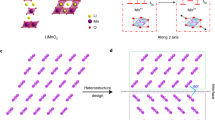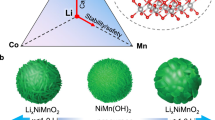Abstract
RECHARGEABLE lithium batteries can store more than twice as much energy per unit weight and volume as other rechargeable batteries1,2. They contain lithium ions in an electrolyte, which shuttle back and forth between, and are intercalated by, the electrode materials. The first commercially successful rechargeable lithium battery3, introduced by the Sony Corporation in 1990, consists of a carbon-based negative electrode, layered LiCoO2 as the positive electrode, and a non-aqueous liquid electrolyte. The high cost and toxicity of cobalt compounds, however, has prompted a search for alternative materials that intercalate lithium ions. One such is LiMn2O4, which has been much studied as a positive electrode material4–7; the cost of manganese is less than 1% of that of cobalt, and it is less toxic. Here we report the synthesis and electrochemical performance of a new material, layered LiMnO2, which is structurally analogous to LiCoO2. The charge capacity of LiMnO2 (∼270mAhg–1) compares well with that of both LiCoO2 and LiMn2O4, and preliminary results indicate good stability over repeated charge–discharge cycles.
This is a preview of subscription content, access via your institution
Access options
Subscribe to this journal
Receive 51 print issues and online access
$199.00 per year
only $3.90 per issue
Buy this article
- Purchase on Springer Link
- Instant access to full article PDF
Prices may be subject to local taxes which are calculated during checkout
Similar content being viewed by others
References
Oyama, N., Tatsuma, T., Sato, T. & Sotomura, T. Nature 373, 598–600 (1995).
Scrosati, B. Nature 373, 557–558 (1995).
Nagaura, T. 3rd Int. Battery Seminar (Deerfield Beach, FL, 1990).
Thackeray, M. M., David, W. I. F., Bruce, P. G. & Goodenough, J. B. Mater. Res. Bull 18, 461–472 (1983).
Huang, H. & Bruce, P. G. J. Power Sources 54, 52–57 (1995).
Tarascon, J.-M. & Guyomard, D. Electrochimica Acta 38, 1221–1231 (1993).
Pistoia, G. & Wang, G. Solid St. Ionics 66, 135–142 (1993).
Rossouw, M. H., Liles, D. C. & Thackeray, M. M. J. Solid St. Chem. 104, 464–466 (1993).
Thackeray, M. M. J. electrochem. Soc. 142, 2558–2563 (1995).
Leroux, F., Guyomard, D. & Piffard, Y. Solid St. Ionics 80, 299–306 (1995).
Fuchs, B. & Kemmler-Sack, S. Solid St. Ionics 68, 279–295 (1994).
Bruce, P. G. & Armstrong, A. R. UK Patent Application January 1996.
Matthewman, J. C., Thompson, P. & Brown, P. J. J. appl. Crystallogr. 15, 167–173 (1982).
Huang, H. & Bruce, P. G. J. electrochem. Soc. 141, L106–L107 (1994).
Author information
Authors and Affiliations
Rights and permissions
About this article
Cite this article
Armstrong, A., Bruce, P. Synthesis of layered LiMnO2 as an electrode for rechargeable lithium batteries. Nature 381, 499–500 (1996). https://doi.org/10.1038/381499a0
Received:
Accepted:
Issue Date:
DOI: https://doi.org/10.1038/381499a0
This article is cited by
-
Mn-based cathode materials for rechargeable batteries
Science China Chemistry (2024)
-
First-principles study on LiMn0.5Fe0.5PO4 doping to decrease the Jahn-Teller effect
Journal of Solid State Electrochemistry (2024)
-
In situ formed partially disordered phases as earth-abundant Mn-rich cathode materials
Nature Energy (2023)
-
Building Better Full Manganese-Based Cathode Materials for Next-Generation Lithium-Ion Batteries
Electrochemical Energy Reviews (2023)
-
A critical review on nickel-based cathodes in rechargeable batteries
International Journal of Minerals, Metallurgy and Materials (2022)
Comments
By submitting a comment you agree to abide by our Terms and Community Guidelines. If you find something abusive or that does not comply with our terms or guidelines please flag it as inappropriate.



